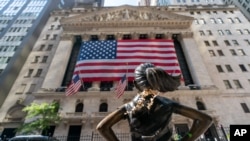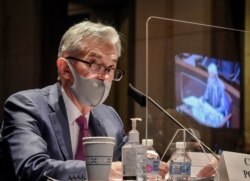Stocks turned sharply lower on Wall Street Tuesday afternoon after President Donald Trump ordered a stop to negotiations with Democrats on a coronavirus economic stimulus bill until after the election.
The S&P index slid 1.3% after Trump tweeted his mandate. The benchmark index had been up 0.7% just prior to the president's announcement with about an hour of trading left.
In a series of tweets about the negotiations between the White House and Speaker Nancy Pelosi, Trump said: "I have instructed my representatives to stop negotiating until after the election when, immediately after I win, we will pass a major stimulus bill that focuses on hardworking Americans and small business." He also accused Pelosi of not negotiating in good faith.
The comments from the president came just hours after Federal Reserve Chair Jerome Powell urged Congress to come through with more aid, saying that too little support "would lead to a weak recovery, creating unnecessary hardship for households and businesses."
Trump's announcement dashes Wall Street's hopes that another round of stimulus for the economy, which has been punched into a recession by shutdowns related to the coronavirus pandemic, could soon be on the way. Bitter partisanship on Capitol Hill has been preventing a compromise on more aid. Reports on the economy have been mixed recently, as some areas show a slowdown after extra unemployment benefits and other stimulus earlier approved by Congress expired.
Wall Street numbers
The Dow Jones Industrial Average was down 359 points, or 1.3%, to 27,785 as of 3:19 p.m. Eastern time. The Nasdaq composite was down 1.4%. Small stocks were holding up better than the rest of the market. The Russell 2000 index of small-cap stocks was up 0.2%.
The market's slide comes a day after the S&P 500 posted its best day in more than three weeks. Other stock markets around the world made mostly modest gains. Longer-term Treasury yields veered lower after Trump's remarks. They had earlier been hanging close to their highest levels in months.
The selling was widespread, led by technology stocks and companies that rely on consumer spending. Utilities were the only gainers among the 11 sectors in the S&P 500.
A report on Tuesday showed that U.S. employers advertised slightly fewer job openings in August than the prior month. But the number was nevertheless better than economists expected.
Trading on Wall Street has gotten even shakier recently as investors contend with a long list of uncertainties, from Trump's COVID-19 diagnosis to waxing and waning expectations about Congress's ability to deliver another round of stimulus for the economy.
The S&P 500 jumped 1.8% on Monday after Trump said he was returning to the White House to complete his recovery from the coronavirus, though his medical team said he is not yet fully "out of the woods."
Powell has repeatedly urged Congress to provide additional aid, saying the Fed cannot prop up the economy by itself, even with interest rates at record lows.
"The expansion is still far from complete," Powell said in a speech to the National Association for Business Economics, a group of corporate and academic economists.
Challenges ahead
Several big challenges lie ahead of markets. Chief among them is the still-raging pandemic, as was so clearly illustrated by Trump's stay in the hospital. The worry is that a ramp-up in infections could cause governments to bring back some of the restrictions they put on businesses early this year, which sent the economy hurtling into a recession.
"We're on the eve of earnings season, and people are reasonably undecided as to whether the correction that started in September has further to run," said Julian Emanuel, BTIG chief equity and derivatives strategist.
The upcoming election also still means a host of uncertainty about tax rates and regulations on businesses, while tensions between the United States and China continue to simmer.
The yield on the 10-year Treasury note fell to 0.75% from 0.78% late Monday. While that is still very low, the yield has been generally climbing since dropping close to 0.50% in early August.
European and Asian markets closed broadly higher.

